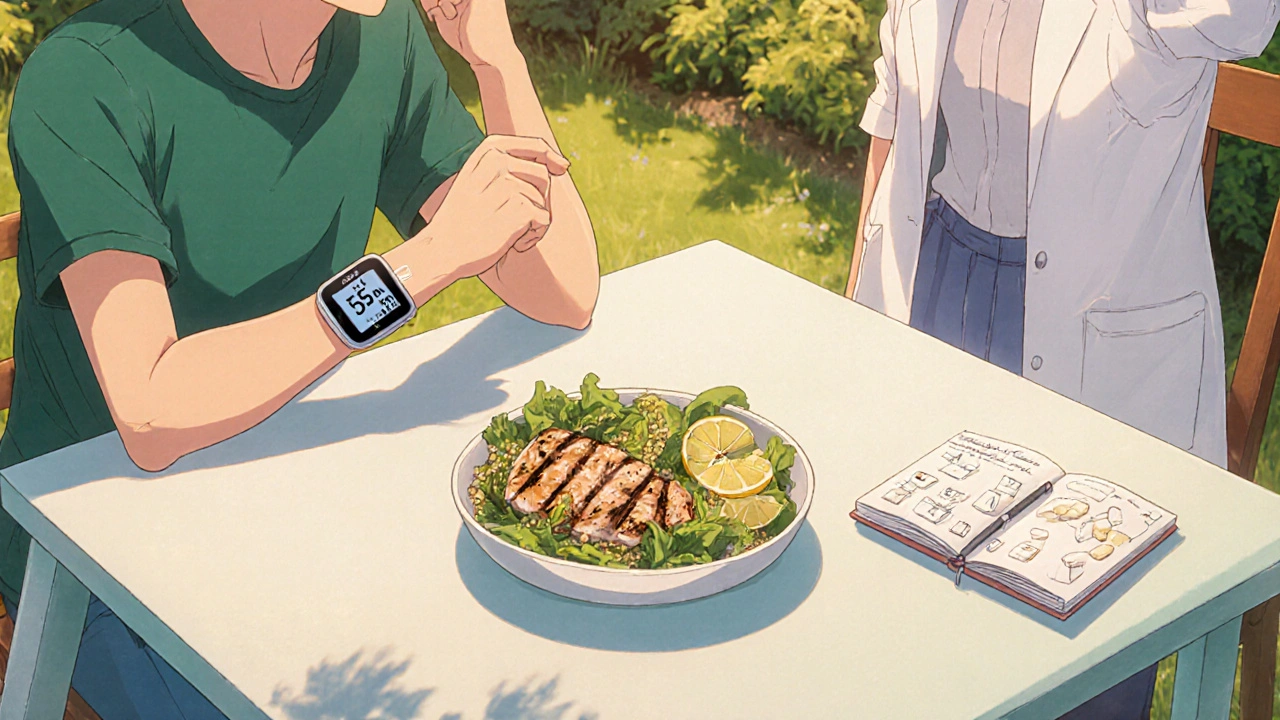Quick Takeaways
- Ivabradine lowers heart rate without affecting blood pressure.
- Certain foods - especially grapefruit and high‑potassium items - can change how ivabradine works.
- A Mediterranean‑style diet supports the drug’s benefits and improves overall heart health.
- Take ivabradine with a light snack, keep timing consistent, and discuss supplements with your pharmacist.
- Regular monitoring of heart rate and electrolytes helps avoid side‑effects.
Living with a heart condition means juggling medication, appointments, and everyday choices. One drug that often appears in the conversation is Ivabradine - a heart‑rate‑lowering medicine approved for chronic heart failure and angina. While the pill does its job, what you eat can either boost its effect or blunt it. This guide walks you through the science, the foods to watch, and practical steps to keep your heart ticking smoothly.
What Is Ivabradine?
Ivabradine is a selective inhibitor of the funny (If) channel in the sino‑atrial node. By slowing the electrical signal that sets the heart’s pace, it reduces resting heart rate without influencing contractility or blood pressure. In the UK, the NHS prescribes it mainly for patients with heart failure who remain symptomatic despite optimal beta‑blocker therapy, and for chronic stable angina when other options aren’t suitable.
How Ivabradine Works - and Why Diet Matters
The drug’s action hinges on precise plasma concentrations. Too low, and the heart rate stays high; too high, and patients may feel dizzy or develop a slow‑heart‑rate bradycardia. Food can affect how quickly ivabradine is absorbed and broken down in the liver, especially through the CYP3A4 enzyme pathway. Some ingredients either block or speed up this enzyme, shifting drug levels by up to 30 %.
Foods and Substances That Interact With Ivabradine
Below is a quick reference of common dietary culprits and why they matter.
| Food / Substance | Effect on Ivabradine | Practical Advice |
|---|---|---|
| Grapefruit | Inhibits CYP3A4 → higher drug levels | Avoid fresh juice, grapefruits, and most marmalades. |
| High‑potassium foods (e.g., bananas, oranges, potatoes) | May exaggerate bradycardia when combined with ivabradine‑induced slow heart rate | Monitor serum potassium; keep intake moderate. |
| High‑sodium foods (processed snacks, cured meats) | Raises blood pressure, counteracting heart‑rate benefits | Prefer fresh, low‑salt options. |
| Caffeine | Stimulates heart rate → may offset ivabradine | Limit coffee/energy drinks to 1-2 cups daily. |
| Herbal supplements (St. John’s wort, ginseng) | Can alter CYP3A4 activity | Discuss any supplements with your pharmacist. |

Heart‑Healthy Diet Patterns That Complement Ivabradine
Rather than a list of “allowed” and “forbidden” items, think of overall eating patterns that support a lower heart rate and stable electrolytes.
- Mediterranean diet: Emphasises olive oil, fatty fish, nuts, legumes, whole grains, and plenty of fruits and vegetables. It provides omega‑3 fatty acids that improve endothelial function and may reduce the need for higher ivabradine doses.
- DASH diet (Dietary Approaches to Stop Hypertension): Focuses on low‑sodium, high‑potassium foods like leafy greens, berries, and low‑fat dairy. This balance helps keep blood pressure in check while you’re on a heart‑rate‑lowering regimen.
- Plant‑rich meals: Aiming for at least half your plate to be non‑starchy vegetables reduces overall calorie density and supports weight management, which in turn lowers cardiac workload.
Sample day:
- Breakfast: Oatmeal topped with blueberries, a sprinkle of walnuts, and a drizzle of extra‑virgin olive oil.
- Lunch: Grilled sardine salad with mixed greens, cherry tomatoes, cucumber, quinoa, and a lemon‑olive‑oil dressing.
- Dinner: Baked chicken breast with roasted sweet potatoes, steamed broccoli, and a side of lentil stew.
- Snacks: A small apple or a handful of unsalted almonds.
Practical Tips for Taking Ivabradine With Food
- Take the tablet with a light snack, not on an empty stomach. Food slows absorption slightly, smoothing out peak levels.
- Keep the timing consistent - most prescriptions are twice daily, 12 hours apart. Set a phone reminder.
- Record any new foods or supplements in a medication diary; share it at your next clinic visit.
- If you miss a dose, take it as soon as you remember unless it’s less than 12 hours until the next dose. In that case, skip the missed one.
- Ask your pharmacist to check for hidden grapefruit in flavored syrups, pre‑made sauces, or vitamin‑C drinks.
Common Pitfalls and How to Avoid Them
Even well‑meaning patients can stumble into problems.
- Assuming “natural” means safe: Herbal teas marketed for heart health may still contain compounds that affect CYP3A4.
- Over‑relying on salt‑free products: Many “low‑sodium” items replace salt with potassium salts, which could push potassium levels higher.
- Skipping meals to avoid calories - an empty stomach can raise ivabradine’s peak concentration, increasing side‑effects.
- Self‑adjusting dose because you feel better - never change the prescribed amount without a clinician’s go‑ahead.

Monitoring and Follow‑Up
Regular check‑ins with your cardiology team are essential. Typical monitoring includes:
- Resting heart rate: Aim for 50-60 bpm; report any drops below 50.
- Electrolytes (potassium, sodium): Blood tests every 3-6 months, especially if your diet is high in potassium.
- Kidney function: Ivabradine is cleared partially by the kidneys; impaired function may require dose adjustment.
- Symptoms: Dizziness, visual phosphenes (bright dots), or fatigue should trigger a call to your healthcare provider.
Bottom Line
Ivabradine can be a game‑changer for heart patients, but its success hinges on more than just swallowing a pill. By steering clear of grapefruit, watching potassium and sodium intake, and embracing a Mediterranean‑style eating plan, you give the drug the best chance to work safely. Pair these choices with consistent dosing, routine monitoring, and open dialogue with your pharmacist, and you’ll be on a solid path toward a steadier heartbeat.
Frequently Asked Questions
Can I drink coffee while taking ivabradine?
A moderate amount - about one to two cups a day - is generally fine. Caffeine can raise heart rate, which may offset ivabradine’s effect, so keep intake low and note any unusual palpitations.
Is grapefruit really that dangerous?
Yes. Grapefruit contains furanocoumarins that block CYP3A4, the enzyme that metabolises ivabradine. This can boost blood levels by 30‑50 %, increasing the risk of bradycardia and visual side‑effects.
Do I need to avoid all potassium‑rich foods?
Not completely. Just keep intake balanced and have your potassium checked regularly. If your blood work shows high levels, your doctor may advise cutting back on bananas, oranges, or potatoes.
What should I do if I miss a dose?
Take it as soon as you remember, unless it’s less than 12 hours until the next scheduled dose. In that case, skip the missed tablet and continue with the regular schedule.
Are there any over‑the‑counter supplements I should avoid?
Yes. St. John’s wort, ginseng, and some high‑dose omega‑3 capsules can interfere with the CYP3A4 pathway. Always check with your pharmacist before adding any supplement.

Joe Moore
October 18, 2025 AT 15:20